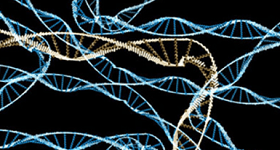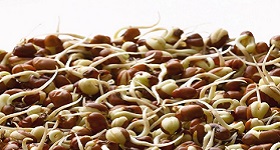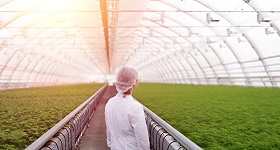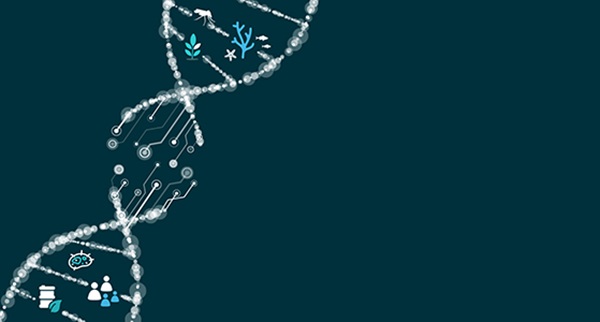Synthetic Biology FSP

March 2020

 |
Hi everybody and welcome to the new year, although being early March and seeing how much we’ve been through already this year you could be forgiven for thinking we’re already half way through! Bushfires and coronavirus have impacted on many people in many different ways, including SynBioFSP folks.
As we move into a new decade it’s a good time to reflect on the growth and success of the Synthetic Biology Future Science Platform (SynBioFSP), as well as looking to what the future has in store for us.
The SynBioFSP was established in Jan 2017 with a mission is to create and foster a step change in national synthetic biology capability, and ultimately to enable creation of new industries and the reinvention of existing industries via transformative synthetic biology technology. The establishment of mechanisms to develop new people and skills and the necessary infrastructure was central to this.
So where are we at the start of 2020?
To date we have funded 13 ‘blue sky’ research projects within CSIRO, 28 SynBio University fellows, 30 PhD top up scholarships, and supported 4 CSIRO post-docs. We have been extremely active in building the national community, including supporting 3 annual SynBioFSP workshops, hosting the SBA2019 conference, sponsoring numerous other workshops and conferences, and engaging strongly with national and international industry and with State and Federal Governments. Members of the SynBioFSP have produced more than 75 publications with many more in the pipeline; their work has been presented at local, national and international conferences and our people have been prolific in public engagement, talking in many different fora on all things SynBio and science.
The CSIRO research projects and the SynBio University Fellows have had a unique opportunity to explore ‘blue sky’ ideas.
As with any program there need to be checks and balances to evaluate the impact of the investment. Over the latter part of 2019, we met with the project leaders and reviewed progress reports from the SynBio University fellows. In addition, we have held workshops with our key CSIRO business unit partners to better understand the strategic alignment, gaps and new opportunities between the CSIRO business units and the SynBioFSP.
This information has informed our strategic plans and helped us to identify where investment is best placed for the next two and a half years.
The BioFoundry is up and running and servicing a variety of projects. We are learning an enormous amount as we go about operationalising a national service facility! The newly added Sciclone robot is our biggest liquid handling platform yet, that will enable us to automate many routine protocols like plasmid extraction.
Meanwhile, we’ve already begun planning for the 2020 SynBio FSP workshop, to be held at Rydges World Square, Sydney on September 15 and 16. Booking and accommodation details to come.
The workshop will be followed immediately by the first ever Australian Synthetic Biology Challenge Showcase. This is a really exciting initiative which will help grow our national undergraduate training capability in synthetic biology – more on this to come, so watch this space.
Just quickly I’d like to touch on the success of the SBA2019 conference and FSP workshop late last year.
SBA2019 saw 226 national and international delegates attend over three days, resulting in excellent science and commercial discussions, strong industry and government engagement, opportunities for side meetings with key government officials and US based SynBio companies with a view to the future. Eight of the abstracts selected for oral presentation were FSP-funded researchers. To our delight, the venue sold out – demonstrating the massive community engagement and huge growth in synthetic biology in Australia. The quality of presentations was outstanding and the feedback for this meeting was fantastic.
Our FSP workshop immediately following was open to all and was attended by 130 delegates – both FSP and external. We heard application domain overviews and exciting FSP project science updates, and held discussion groups to identify priorities as part of our strategic planning activities. We finished off the day with an Early Career Researchers ON workshop, which was part of the Australian Academy of Science-funded ECR program that ran across both SBA2019 and the SynBioFSP workshop.
Thanks to all those who attended both events and a big shout out to the organising committees that made it all possible – especially Louise Burton and Emily Knauth, who did an amazing job of event organisation and support.
Regards
Claudia
Assoc. Professor Claudia Vickers
Director
CSIRO Synthetic Biology Future Science Platform
 " After="" />
" After="" />
A new approach for ethically sharing the benefits of biological resources, science and technology is urgently needed to conserve biodiversity, according to a group of international researchers (including one of our FSP Future Science Fellows) in a paper published in Science today.
 " After="" />
" After="" />
Late last year the world’s first genetically modified (GM) cowpea was registered and approved for release to smallholder farmers in Nigeria. The new variety carries a microbial insecticidal gene making it resistant to a major pest that affects this crop.
 " After="" />
" After="" />
A careful study of evolutionary theory shows that there are more routes to complexity than simple improvement in function. Synthetic Biology FSP Future Science Fellow Dr Matt Baker looks at how the road to complexity can also involve a change of function
 " After="" />
" After="" />
For agriculture to continue to grow amid the complex challenges of food security and climate change, innovations like those offered by the new field of synthetic biology could be key.
 " After="" />
" After="" />
Synthetic biology therefore allows us to explore places where evolution has never gone – and in some cases, probably never would go. It means we can reach outcomes chosen to meet human needs, instead of evolutionary pressures.

Check out our new hub where you can find out all the latest FSP staff news
Funding opportunities, position vacancies, staff movements, upcoming events: get it all here, in real time. You can bookmark the page or sign up to the RSS feed using these simple instructions.
Clark, M., & Maselko, M. (2020). Transgene Biocontainment Strategies for Molecular Farming. Frontiers in Plant Science, 11(210). doi:10.3389/fpls.2020.00210 2020
Fabris, Michele*; George, Jestin; Kuzhiumparambil, Unnikrishnan; Lawson, Caitlin; Jaramillo-Madrid, Ana Cristina; Abbriano, Raffaela; Vickers, Claudia; Ralph, Peter (2020). Extra-chromosomal metabolic engineering of the marine diatom Phaeodactylum tricornutum enables the heterologous production of monoterpenoids 2020 ACS Synthetic Biology 10.1021/acssynbio.9b00455
Li, J., Pollak, N. M., & Macdonald, J. (2019). Multiplex Detection of Nucleic Acids Using Recombinase Polymerase Amplification and a Molecular Colorimetric 7-Segment Display. ACS Omega, 4(7), 11388-11396. doi:10.1021/acsomega.9b01097 2019 OCS Omega
Harding, B. I., Pollak, N. M., Stefanovic, D., & Macdonald, J. (2019). Repeated Reuse of Deoxyribozyme-Based Logic Gates. Nano Letters, 19(11), 7655-7661. doi:10.1021/acs.nanolett.9b02326 2019
MAB Baker, AJ Brown (2019), A detour to sterol synthesis, Nature Microbiology (News & Views), 4, 214–215. 2019
Nieves, D. J., Hilzenrat, G., Tran, J., Yang, Z., MacRae, H. H., Baker, M. A. B., . . . Gaus, K. (2019). tagPAINT: covalent labelling of genetically encoded protein tags for DNA-PAINT imaging. R Soc Open Sci, 6(12), 191268. doi:10.1098/rsos.191268 2019 Royal Society Open Science
Darley, E., Singh, J. K. D., Surace, N. A., Wickham, S. F. J., & Baker, M. A. B. (2019). The Fusion of Lipid and DNA Nanotechnology. Genes (Basel), 10(12). doi:10.3390/genes10121001 2019 Genes
Dennis M.L.; Esquirol L., Nebl T., Newman J., Scott C., Peat T.S. The evolving story of AtzT, a periplasmic binding protein. ACTA CRYSTALLOGRAPHICA SECTION D-STRUCTURAL BIOLOGY. 75: 995-1002. 2019 ACTA CRYSTALLOGRAPHICA SECTION D-STRUCTURAL BIOLOGY. 75: 995-1002.
"Espinosa, Monica, I; Williams, Thomas C.; Pretorius, Isak S; Paulsen Ian T. 6. Benchmarking two Saccharomyces cerevisiae laboratory strains for growth and transcriptional response to methanol. " 2019 SYNTHETIC AND SYSTEMS BIOTECHNOLOGY. 4: 180-188
Xu, Xin; Williams, Thomas C.; Divne, Christina; Pretorius Isak S., Paulsen Ian T. Evolutionary engineering in Saccharomyces cerevisiae reveals a TRK1-dependent potassium influx mechanism for propionic acid tolerance. 2019 BIOTECHNOLOGY FOR BIOFUELS 12: 97
Ramarajan, M., Fabris, M., Abbriano, R., Pernice, M., & Ralph, P. (2019). Novel endogenous promoters for genetic engineering of the marine microalga Nannochloropsis gaditana CCMP526. Algal Research, 44. doi:10.1016/j.algal.2019.101708 2019
Pouvreau, Vanhercke, Singh (2018) From plant metabolic engineering to plant synthetic biology: The evolution of the design/build/test/learn cycle. Plant Science 273: 3-12 2019 Plant Science 273: 3-12
Guo, Z., Johnston, W.A., Whitfield, J., Walden, P., Cui, Z., Wijker, E., Edwardraja, S., Retamal Lantadilla, I., Ely, F., Vickers, C., Ungerer, J.P.J., Alexandrov, K. Generalizable Protein Biosensors Based on Synthetic Switch Modules 2019 Journal of Amercian Chemical Society 141: 8128-8135
Ignea, Codruta; Raadam, Morten H.; Makris, Antonios M.; Vickers, Claudia E.; and Kampranis, Sotirios C. * (2019) Orthogonal monoterpenoid biosynthesis in yeast constructed on an isomeric substrate. 2019 Nature Communications;
Wurtzel Eleanore T.*, Vickers, Claudia E.*; Hanson, Andrew D.*; Millar, A. Harvey; Cooper, Mark; Voss-Fels, Kai P.; Nikel, Pablo I.; Erb, Tobias J. Revolutionizing agriculture with synthetic biology. In Press, Nature Plants. 2019 Nature Plants doi:10.1038/s41477-019-0539-0
Vavitsas, Konstantinos; Crozet, Pierre; Hamborg Vinde, Marcos; Davies, Fiona; Lemaire, Stéphane D.; Vickers, Claudia E. (2019) The synthetic biology toolkit for photosynthetic microorganisms. Plant Physiology. Accepted, 9/06/2019; doi.org/10.1104/pp.19.00345
Hillson, N., Caddick, M., Cai, Y., Carrasco, J. A., Chang, M. W., Curach, N. C., … Freemont, P. S. (2019). Building a global alliance of biofoundries. Nature Communications, 10(1), 2040. https://doi.org/10.1038/s41467-019-10079-2
Alissandratos A, Hartley CJ, French NG, Kim HK, Allen S, Estavillo GM, Scott C & Easton CJ. (2019) One-pot multi-enzymatic transformation of NH3 and CO2 into the organic nitrogen plant fertilizer citrulline using a single recombinant lysate of E. coli. Sus Chem Eng 2019
Bashiri G, Antoney J, Jirgis ENM, Shah MV, Ney B, Copp J, Stuteley SM, Sreebhavan S, Palmer B, Middleditch M, Tokuriki N, Greening C, Scott C, Baker EN & Jackson CJ. (2019) A revised biosynthetic pathway for the cofactor F420 in prokaryotes. Nat. Comm. 10: 1558. 2019
Hartley CJ, Williams CC, Scoble JA, Churches QI, North A, French NG, Nebl T, Coia G, Warden AC, Simpson G, Frazer AR, Jensen CN, Turner NJ & Scott C. Engineered Enzymes that Retain and Regenerate their Cofactors Enable Continuous-Flow Biocatalysis. Nature Catalysis 2: 1006-1015.
Eddleston M, Clutton RE, Taylor M, Thompson A, Worek F, John H, Thiermann H, Scott C. Efficacy of an organophosporous hydrolase enzyme (PpdA) in human serum and minipig models of organophosphorous insecticide poisoning. Clincial Toxicology 2019 https://doi.org/10.1080/15563650.2019.1655149 2019
Shah MV, Antoney J, Kang SW, Warden AC, Hartley CJ, Nazem-Bokaee H, Jackson CJ, Scott Colin. Cofactor F420 dependent enzymes: an under-explored resource for asymetric redox biocatalysis. Catalysts 2019 9(10) https://doi.org/10.3390/catal9100868
Stoddard, A and Rolland V. Which fluorescent tag to use in an acidic environment? Investigating the in vivo pH resilience of fluorescent proteins targeted to plant cell walls. Plant Direct, Volume3, Issue1, January 2019 2019 1
Stoddard, A, Rolland, V. I see the light! Fluorescent proteins suitable for cell wall/apoplast targeting in Nicotiana benthamiana leaves. Plant Direct. 2019; 3: 1– 15. https://doi.org/10.1002/pld3.112 2019 Plant Direct. 2019; 3: 1– 15. https://doi.org/10.1002/pld3.112
Protein engineering: the potential of remote mutations.” Matthew Wilding, Nansook Hong, Matthew Spence, Ashley M. Buckle, Colin J. Jackson Biochemical Society Transactions, 2019
Ana Cristina Jaramillo-Madrid, Justin Ashworth, Michele Fabris, Peter J. Ralph, Phytosterol biosynthesis and production by diatoms (Bacillariophyceae), Phytochemistry, Volume 163, 2019, Pages 46-57, ISSN 0031-9422, 2019
Audrey S. Commault, Michele Fabris, Unnikrishnan Kuzhiumparambil, Jack Adriaans, Mathieu Pernice, Peter J. Ralph, Methyl jasmonate treatment affects the regulation of the 2-C-methyl-D-erythritol 4-phosphate pathway and early steps of the triterpenoid biosynthesis in Chlamydomonas reinhardtii, Algal Research-BIOMASS BIOFUELS AND BIOPRODUCTS, Volume 39, 2019, 101462, ISSN 2211-9264